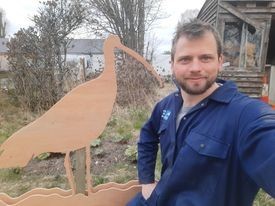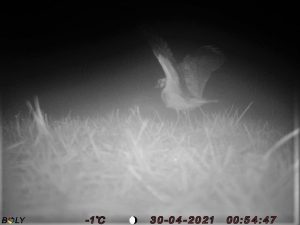Teuchat Tales: The 2021 breeding wader season part 2

Teuchat Tales: The 2021 breeding wader season part 2
Between April and the end of June, we are bringing you the story of the 2021 wader breeding season, from the perspective of the partners involved in the Strathspey Wetland and Waders initiative (SWWI)
Our breeding waders across the country face all sorts of challenges and there are differing opinions on the key causes of decline. Broadly there are two main schools of thought: either it is the changes to farming practices and land use, and the fact that waders can’t quite keep up with the changes, or it is predation that is the key driving factor. In reality, both are relevant and if we want to maintain our wader populations, and even help some recover, I personally feel we’re at the stage where both issues have to be addressed.
While that discussion rages on, this season there is a very significant additional factor affecting our nesting waders: the flipping weather! Our SWWI surveys consist of three visits between mid-April and mid-June and so far it’s been a constant battle to find a window of good weather to get out and do the surveys. April was really cold, with a particularly bad arctic blast at the beginning of the month. Birds had been settling onto their territories but that extreme weather set things back and birds in some places were observed flocking up again. It appears that in some cases birds may have even have abandoned sites and given up for the season.
It remained pretty cold throughout April and into May, I woke up in my mini camper van at 4:30 on 29th April to do a survey in Tomintoul and there was a nice layer of snow blanketing everything. Have you ever tried to spot lapwing in fields covered in snow? It’s not easy. Four days later I woke up in a different part of Glenlivet for another survey and had to scrape a really hard layer of ice off the outside of the windscreen (and a slightly thinner layer from the inside!)
So the consensus is that the birds laid a bit later this year, and it wasn’t until late April that we were seeing the majority of birds on eggs. Cold weather during incubation isn’t a complete disaster, however, once the cold weather departed, along came the wet weather and unfortunately, it was around the time that we first started to see significant numbers of newly hatched chicks.
I saw my first chicks on 19th May when I was checking nest cameras. I had a very brief look at one nest last Tuesday afternoon and there were still eggs but on Wednesday morning I popped back to change the camera batteries and the two eggs were two chicks!
It didn’t stop raining for what seemed like an eternity, and it wasn’t nice spring-like showers, it was freezing February-type rain. Sadly, cold, wet and hungry chicks don’t often survive but the weather forecast looks considerably better, and hopefully it gets easier for the chicks that have made it this far.
The trail camera project has been very interesting to be a part of, an opportunity for me to get a bit of experience using these cameras on nests. We’ve had three cameras on a couple of sites in Strathspey and another three on a small field in Glenlivet, which has at least seven wader nests. We’ve been counting these birds since 2000 and we need to start trying to find out how successful they are in terms of breeding. Next Spring, we hope to crank up this work and do something a lot more significant, we will have access to more cameras and we will be able to achieve more comprehensive coverage over a complete farm or survey area.
So what have we discovered so far this season? In Strathspey, we monitored a total of six nests, an oystercatcher and a lapwing nest have hatched and one is due to hatch any day now. Two lapwing nests were predated by a badger and another by a stoat or a rat (the photos aren’t clear and opinion is divided). This was the start of some drama and ultimately the nest was predated
In Glenlivet, we had another three cameras on a total of four nests. As of last week, one has hatched, one was in the process of hatching, one was still incubating and we believe the last one was predated. In the same field, there have been at least three more lapwing and two oystercatcher nests, we don’t have cameras on them but from a distance, they look like they have been successful – despite the fact we caught images of a fox on one of the trail cams.
In addition to the nest cams, I’ve also got 2 cameras on wetland areas with scrapes.
Who doesn’t like a stoat? I’m not actually that keen when one is chasing a snipe in the breeding season, but what a great clip.
I’ve spent some great mornings and evenings enjoying curlew this season (despite the weather). Such an enigmatic bird.
I put videos on my Twitter account too: @vickyjanderson2 Please have a look, “like” and “retweet” and let’s share the Cairngorms National Park wader love.
In the next blog, I will give you an update and a bit more of the story of each of the nests.
 Finally, in Kingussie and Newtonmore on 21st April you may have seen the strange sight of a chap cycling with a giant wooden curlew in tow. This was Thijs from RSPB Insh Marshes Nature Reserve, celebrating World Curlew Day. www.curlewaction.org/world-curlew-day/. More about this and his work in a future blog.
Finally, in Kingussie and Newtonmore on 21st April you may have seen the strange sight of a chap cycling with a giant wooden curlew in tow. This was Thijs from RSPB Insh Marshes Nature Reserve, celebrating World Curlew Day. www.curlewaction.org/world-curlew-day/. More about this and his work in a future blog.
Alert
Latest from the National Park
Update on wildfire situation
Convener Sandy Bremner and Chief Executive Grant Moir have given an update on the ongoing wildfire situation.
Statement on wildfires
An update from Grant Moir, Chief Executive of the Cairngorms National Park Authority, on the ongoing wildfires in Moray and Highland.
New Nethy houses get green light
Meeting in Ballater, the Planning Committee approved applications for a development of 35 houses in Nethy Bridge and a floodplain restoration scheme on the River Dee.
Relevant alerts
-
As a result of ongoing efforts to tackle wildfires to the north of the Cairngorms National Park, several roads are currently closed. Scottish Fire and Rescue are in attendance and the public are advised to avoid the area, including footpaths. Road users are asked not to ignore road closed signs.
The affected roads are:
- B9007 Ferness to Duthil
- U2379 Lochindorb Road
- B939 Ferness to Grantown-on-Spey
- U2347 Braes of Castle Grant
For all the latest information check out the Scottish Fire and Rescue Service and Police Scotland website and social media.






